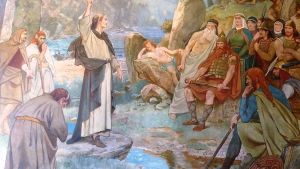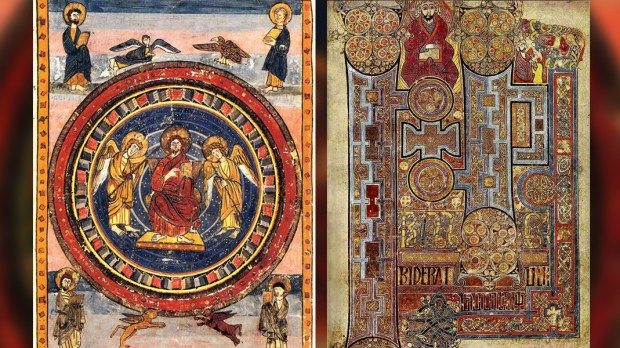Not much is known of the life and works of Saint Ceolfrid. Venerated in both the Catholic and the Orthodox Churches, we know for sure he was the Anglo-Saxon abbot of St. Paul’s Monastery (also known as Monkwearmouth-Jarrow Abbey) in England; that he was born in Burgundy, France; that he was the warden of Bede the Venerable; and that he commissioned three copies of the Bible somewhere around the year 692. One of these three copies is the invaluable Codex Amiatinus, the earliest surviving copy of St. Jerome’s 4th-century translation of both the Hebrew and the Greek Bibles (that is, the Old and New Testaments) into Latin, the Vulgate.

Read more:
Archaeologists find the cell of St. Columba, one of the “Twelve Apostles of Ireland”
About Saint Columba, the “Apostle to the Picts,” we know a bit more. Considered one of the Twelve Apostles of Ireland, Columba was, like Ceolfrid, a monk and a preacher. Like Ceolfrid, he was the abbot of a monastery (the famous Abbey of Iona, which became one the main centers of cultural and political activity in the region for centuries). Being the patron saint of Kells, his name and life are associated with the famous Book of Kells, the exceptional Irish illuminated manuscript, written in Latin, containing the four Gospels alongside some prefatory texts and tablets. In fact, some sources say the book is the work of Columba’s own hands.
Last October 26, Josephine Livingstone published an exceptional article in the New Yorker, “The Complicated Political Life of Medieval Manuscripts,” in which she wonders why these two manuscripts are preserved in such different ways, being as they are probably the two most important Christian manuscripts preserved to this day. In fact, the Codex Amiatinus is “condemned to live under a blanket” in the Biblioteca Medicea Laurenziana in Florence, while the Book of Kells is on permanent display, behind glass, at Trinity College Library, in Dublin. Interestingly, Livingstone claims “the answer is political.”
The Book of Kells became famous in the nineteenth century, during the Celtic revival (…) The Irish nationalists who took the Book of Kells to heart were subverting the centralized power of the Catholic Church, located in Rome for centuries. The Book of Kells came to symbolize Irish cultural heritage (…) James Joyce described the book, in a letter to the gallerist Arthur Power, as “the most purely Irish thing we have.” Like Joyce, the Book of Kells is a linchpin of Irish identity and thus a key element in the political matrix of its nationhood. The Codex Amiatinus, in a strangely symmetrical kind of opposition, belongs to a nation overflowing with historical legacies. Amiatinus is undoubtedly a priceless treasure in Italy, but it is a priceless treasure among countless priceless treasures.
Regardless of the specific value both books might for either the Irish or the Italian, the good news is that both books are well preserved and accessible to (almost) everyone today. In fact, they have both been digitized, almost entirely. If you want to read Livingstone’s article in its entirety, you can click here.

